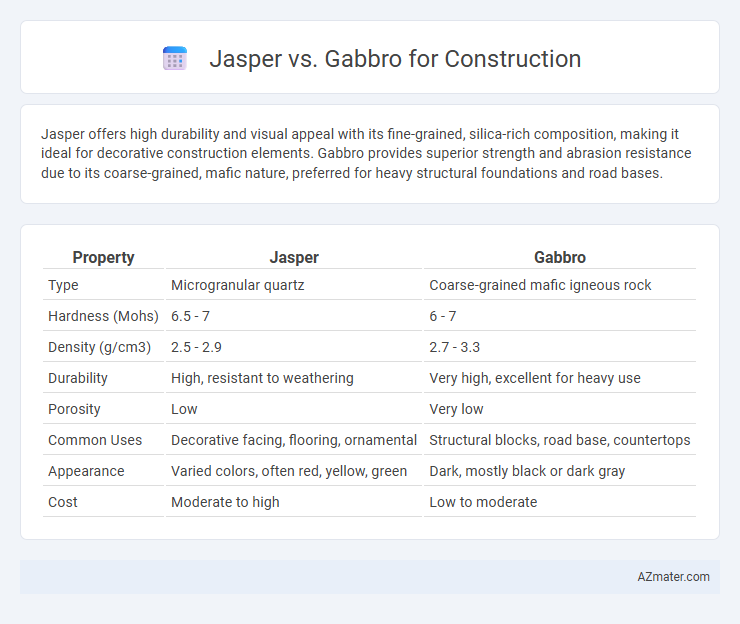Jasper offers high durability and visual appeal with its fine-grained, silica-rich composition, making it ideal for decorative construction elements. Gabbro provides superior strength and abrasion resistance due to its coarse-grained, mafic nature, preferred for heavy structural foundations and road bases.
Table of Comparison
| Property | Jasper | Gabbro |
|---|---|---|
| Type | Microgranular quartz | Coarse-grained mafic igneous rock |
| Hardness (Mohs) | 6.5 - 7 | 6 - 7 |
| Density (g/cm3) | 2.5 - 2.9 | 2.7 - 3.3 |
| Durability | High, resistant to weathering | Very high, excellent for heavy use |
| Porosity | Low | Very low |
| Common Uses | Decorative facing, flooring, ornamental | Structural blocks, road base, countertops |
| Appearance | Varied colors, often red, yellow, green | Dark, mostly black or dark gray |
| Cost | Moderate to high | Low to moderate |
Introduction to Jasper and Gabbro in Construction
Jasper, a dense and durable form of microcrystalline quartz, is valued in construction for its hardness and resistance to weathering, making it ideal for decorative aggregates and facing stones. Gabbro, a coarse-grained igneous rock rich in plagioclase and pyroxene, is widely used as crushed stone in road building, concrete aggregate, and railway ballast due to its strength and minimal porosity. Both rocks offer distinct advantages in construction, with jasper suited for aesthetic applications and gabbro favored for structural purposes.
Geological Formation and Composition
Jasper is a microcrystalline variety of quartz composed mainly of silicon dioxide, characterized by its dense, hard structure and vibrant red, yellow, or green iron oxide impurities formed through sedimentary and volcanic processes. Gabbro, a coarse-grained mafic intrusive igneous rock, consists primarily of plagioclase feldspar and pyroxene, forming deep within the Earth's crust from slow-cooling magma. The distinct mineral composition and formation depth of gabbro provide superior durability and strength compared to the more brittle, silica-rich jasper, influencing their use and performance in construction applications.
Physical Properties Comparison
Jasper exhibits high hardness (around 6.5-7 on Mohs scale) and excellent abrasion resistance, making it suitable for durable construction surfaces, while gabbro, typically with a Mohs hardness of 6-7, offers exceptional compressive strength and low porosity essential for structural foundations. Jasper's dense and fine-grained composition provides strong resistance to weathering, whereas gabbro's coarse-grained texture contributes to enhanced load-bearing capacity and thermal stability. Both materials demonstrate significant durability, but gabbro's superior mechanical strength often makes it more favorable for heavy-load bearing construction elements.
Strength and Durability in Building Applications
Jasper and gabbro are both igneous rocks used in construction, but gabbro offers superior strength and durability due to its coarse-grained texture and high density, making it ideal for load-bearing structures and heavy-duty applications. Jasper, primarily a form of chalcedony, is less commonly used in structural projects because of its brittleness and lower compressive strength compared to gabbro. For long-lasting building foundations and exterior cladding, gabbro provides enhanced resistance to weathering and mechanical stress, resulting in greater longevity and reduced maintenance costs.
Aesthetic Appeal and Color Variations
Jasper and Gabbro differ significantly in aesthetic appeal and color variations, with Jasper prized for its rich, vibrant hues ranging from deep reds and yellows to greens and browns, showcasing intricate patterns that add unique character to construction projects. Gabbro, typically darker with more uniform black or dark grey tones, offers a sleek and modern look preferred for minimalist designs. These distinct coloration properties make Jasper ideal for decorative elements and Gabbro suitable for structural and exterior applications requiring durability and subtle elegance.
Workability and Ease of Shaping
Jasper features fine-grained texture and hardness that make it relatively difficult to shape but provides strong durability for construction projects. Gabbro offers coarser grains and a more uniform mineral composition, enhancing workability and making it easier to cut and shape compared to jasper. Both stones provide excellent compressive strength, but gabbro's superior workability makes it more suitable for applications requiring precise shaping and detailed architectural elements.
Resistance to Weathering and Erosion
Jasper exhibits superior resistance to weathering and erosion due to its dense, microcrystalline quartz composition, making it highly durable in harsh environmental conditions. Gabbro, composed mainly of coarse-grained pyroxene and plagioclase, has moderate weathering resistance but is more susceptible to chemical breakdown and physical erosion over time. Construction projects prioritizing longevity and minimal maintenance in exposed areas often favor jasper for its enhanced durability against weathering and erosion.
Cost and Availability in the Market
Jasper is generally more expensive than gabbro due to its rarity and attractive, polished appearance, making it less commonly used in heavy construction. Gabbro is abundant and widely available, resulting in lower costs and making it a preferred choice for large-scale construction projects like road bases and aggregates. The market availability of gabbro ensures consistent supply, while jasper's limited deposits restrict its use primarily to decorative elements rather than structural applications.
Common Construction Uses for Jasper and Gabbro
Jasper, with its dense and fine-grained structure, is commonly used for decorative elements such as tiles, countertops, and ornamental facades in construction due to its vibrant colors and durability. Gabbro, a coarse-grained intrusive igneous rock, is favored for heavy construction purposes including road base, aggregates, and dimension stone for buildings because of its high strength and abrasion resistance. Both rocks provide reliable materials, with jasper prized more for aesthetic applications and gabbro utilized for structural and foundational uses.
Conclusion: Best Choice for Construction Needs
Jasper offers superior hardness and aesthetic appeal, making it ideal for decorative construction elements, while gabbro excels in durability and resistance to weathering, suitable for structural applications. For heavy-duty construction requiring strength and longevity, gabbro is the optimal choice due to its coarse-grained texture and robust composition. Jasper suits projects prioritizing design and visual impact, but gabbro's mechanical properties make it the best overall choice for construction needs.

Infographic: Jasper vs Gabbro for Construction
 azmater.com
azmater.com